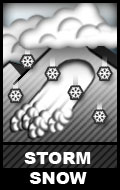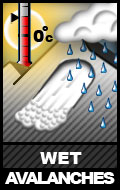Advisory based on observational knowledge and weather forecast available at the time of posting. Accuracy is subject to temporal and spatial variability. Read the disclaimer and conduct your own assessment of conditions accordingly. Accuracy expiration is less than 24 hours.
Monday:
What you need to know:
Dangerous avalanche conditions exist and will likely persist through Tuesday. Travel in avalanche terrain is not recommended unless you possess expert-level backcountry travel, hazard evaluation, and decision-making skills.
A winter weather advisory is currently in effect for the Anchorage Avalanche Center’s advisory area.
The avalanche danger is again increasing back to considerable where it will likely remain through Tuesday. Expect the peak in avalanche danger to be late Monday through early Tuesday, as the possibility for another 1-2′ of new snow is once again on tap for our local mountains. There is the possibility of the avalanche danger trending towards high in some areas. New snow will be sitting on the existing 1-2′ (on average) of snow from the Saturday-Sunday storm.
If the snow abates Tuesday and winds remain light as currently forecast, a gradually decreasing avalanche danger trend should begin later in the day on Tuesday as the snowpack begins to adjust to its new load, old and new surface snow has time to bond, and a stabilizing trend commences.
Danger trend:
Increasing through Monday into Tuesday.
Primary Concerns:
As of Sunday afternoon, the Saturday-Sunday storm snow was loose, hadn’t yet formed much of a slab, and wasn’t much of a problem. However, the Sat-Sun storm snow rests on a relatively hard and slick base (melt-freeze crust and windboard) in many areas on east, south, and west aspects. On north aspects, the Sat-Sun storm snow rests on a varying base ranging from hard windboard to soft powder. North aspects, and other sheltered areas, were also harboring faceted surface snow and spotty surface hoar before the Sat-Sun storm. All this considered, with the Sat-Sun storm snow having had time to settle into a slab and now being loaded with the Monday-Tuesday storm snow, the various harder and slicker old snow surfaces with weak surface snow in certain areas may provide the right combo of slab/weak layer/interface/bed surface to produce significantly dangerous avalanches. Avalanches that pull out into the Sat-Sun storm snow could easily be 2+’ deep.
Loose snow avalanches are likely in the surface snow from the Mon-Tues storm. On Sunday afternoon, large loose snow avalanches that appeared to have occurred naturally during the tail-end of the Sat-Sun storm were observed. Similar avalanches are likely to occur again during the Mon-Tues storm, but may have the potential to step-down and pull out deeper slabs (as discussed above) as they descend.
With similar to more total storm snow from the Mon-Tues storm than the Sat-Sun storm, and considering the potential for deeper slabs to be reactive in the Sat-Sun storm snow, the Mon-Tues storm will likely create more serious avalanche problems than Sat-Sun storm did.
Although mountain top winds in the forecast area are currently light and forecast to remain so for the short term, some moderate winds at the higher elevations are likely and will exacerbate new snow instabilities by creating sensitive wind slabs and building cornices. There were pockets of soft wind slab in the Sat-Sun storm snow, but they weren’t much of an issue before the Mon-Tues storm. However, further loading from the Mon-Tues storm may make these now buried pockets of wind slab more reactive. In addition, new pockets soft wind slab are likely to form during the Mon-Tues storm.
The weather forecast is calling for, and mountain weather stations are currently reporting, light northerly winds which may increase enough to load southerly aspects. However, the channeling effects of mountainous terrain (the topography) will create the potential for new, soft wind slabs on various aspects.
Peripheral Concern:
If the weather forecast holds, wet avalanches shouldn’t be a concern in the short term. However, if the sun comes out, wet avalanches will be a serious issue to contend with considering the new snow that will quickly become wet and be prone to sun-induced shedding in the form of wet-loose avalanches. Such wet-loose avalanches, should the sun come out and they occur, may have the potential to trigger deeper instabilities in both the Sat-Sun and Mon-Tues storm snow as they descend.
Travel Advice:
Visibility is likely to remain low through Tuesday as the Anchorage area Chugach (Front Range and Eagle River) is enshrouded by another big storm. Low visibility will hide potentially dangerous slopes, their runout zones above and around you, as well as other features of concern that might normally alert you as to lurking avalanche problems.
Be on the lookout for red flags of instability like shooting cracks, collapsing or “whumphing“, and clues as to recent avalanches (likely only to be clues considering the lack of visibility and inability to see thoroughly). In assessing the wind slab concern, be on the lookout for some of the typical characteristics such as a rounded or “pillowy” look and hollow or “slabby” feel.
Mountain Weather:
Expect low visibility with snow continuing steadily until Tuesday afternoon, when forecast to gradually start tapering off. The potential for another 1-2′ of new snow is on tap for the Front Range and Eagle River mountains. Light northerly winds are forecast. Mountain temperatures are likely to be in the teens during the day.
Avalanche Outlook:
Tuesday, April 9
Snow should be decreasing in intensity and tapering off through the day. The peak in considerable avalanche danger, which may reach high in some areas, may occur early Tuesday before beginning the gradually decreasing trend later in the day.
Wednesday, April 10
If the weather forecast (current as of Monday morning) holds, avalanche danger should be on the decline from considerable and trending towards moderate.




